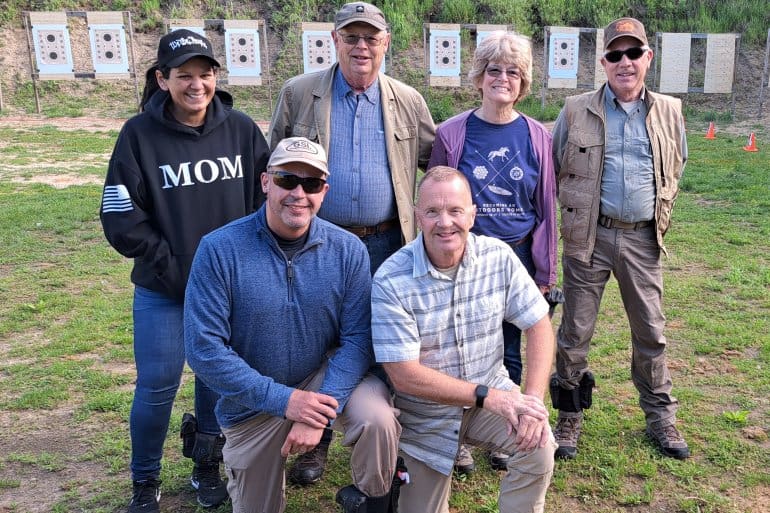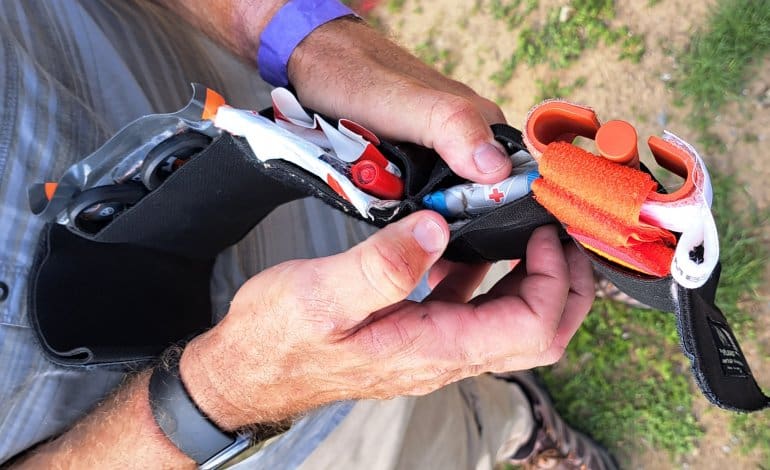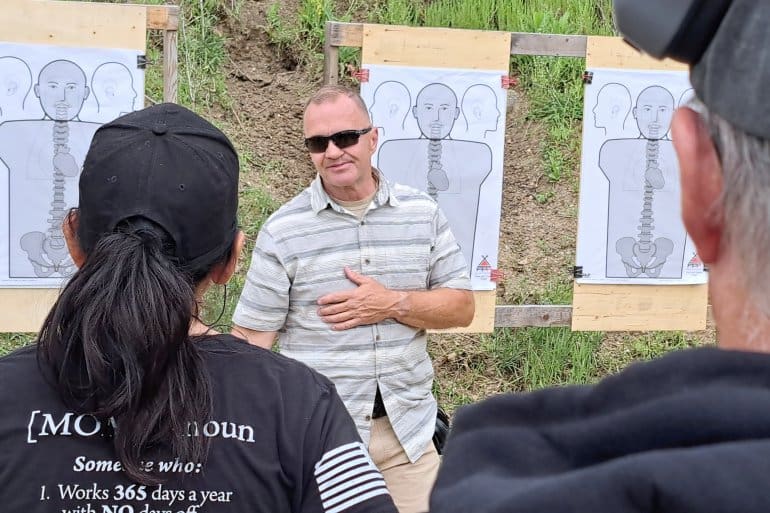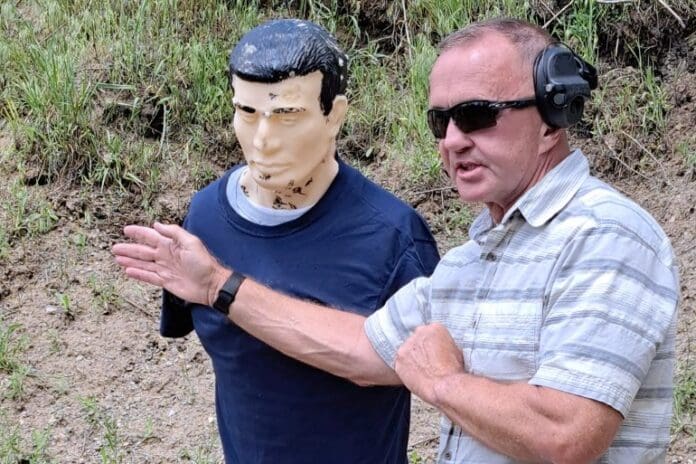Chicago has an armed robbery and carjacking problem. We all know that.
“But I don’t live in that urban hellscape known as Chicago, so I don’t have to worry about that so much,” most readers might say.
That mental denial response has no survival value. Bigger cities see more bad guys, but they work in every locale. And why not? Many see little worry of arrest, prosecution or incarceration in the Land of Lincoln for committing serious crimes. Why even if they get caught, word is out that they don’t even have to post bail now to get released following arrest thanks to Illinois’ new “No Cash Bail” law!
Enter John Murphy’s Street Encounter Skills and Tactics from FPF Training. Murphy cut his teeth as an analyst with one of those alphabet intelligence agencies in Washington. He brings that same analytical process to his other love: helping good guys and gals mentally prepare for a potential attack, and to identify bad guy behaviors and avoid potential threats.
Several of our GSL Defense Training team signed up for this course held at the Illinois State Rifle Association range in Bonfield, Illinois.

We have seen Mr. Murphy in action at the annual “Polite Society” Tactical Conference which derives its name from the skilled and well-armed participants there to study the art of self-defense. Instructors from across the nation attend this event each year.
Our people came into Murphy’s class with a high level of situational awareness training, having taught those best practices as part of force-on-force classes. And honestly, some of our material came from Murphy’s abbreviated presentations at TacCon.
In the Street Encounter two-day class, Murphy supplements the classroom content with six-plus hours of required videos. Among those video lectures, he emphasizes conflict avoidance and de-escalation, stopping bleeding, interacting with law enforcement and pepper spray deployment along with street encounter skills.
To reinforce those points, he incorporates real-life videos of what happens when people let their egos or mouths buy themselves a ticket to a very bad outcome. The numerous crime videos also showed previolence indicators that bad guys “leak” before their attacks, including the big one: the straight-line approach immediately before the attack.
The other reason for the videos? They will likely be admissible in court should class members ever need to prove up their knowledge base relating to common pre-violence indicators to a jury. Not only that but Murphy says he will also make himself available as an expert witness for past students who find themselves involved in a trial following a defensive use of force.
Training Day One was spent on reviewing the high points in the online videos, emphasizing key points and quizzing students. We covered the legalities of using force, interactions with 911 operators, along with responding and investigating police officers (Gimme an “S…T…F…U…” What’s that spell? “I want my attorney!”).
He strongly urged everyone to get a self-defense legal insurance product. He’s a member of Armed Citizens Legal Defense Network, but says who you sign up with is less important than actually signing up with someone after you’ve researched the products thoroughly.
Early in the day he issued each student a can of POM pepper spray and two inert trainers, along with an ankle-carry trauma kit that included a CAT tourniquet and an Israeli Battle Dressing.

For the rest of the class, he treated us to seemingly random “Search and Assess” drills where we were to search and assess for bleeding and treat as appropriate with a TQ or a battle dressing. Frankly, those became annoying at times but helped students new to these tools internalize how to quickly and efficiently employ them on various body appendages. He treated us to a dozen or more of these deployments over the weekend. It was all part of his comprehensive “Before, During and After” paradigms. As he noted, sometimes good guy bleeding follows shootings.
Murphy’s a fan of pepper spray. Personally, I’m not. However, it does serve a narrow niche between a harsh word and going hands-on with a bad guy. While the POM canisters are small and don’t dispense a huge amount of product, Murphy describes them as delivering “plenty of misery.” I’ll take his word for it. We didn’t get exposed to any live agent in the class, and I didn’t volunteer for an application either.
Using the inert trainers, Murphy showed how to carry it for discrete draws and then how and where to deliver a good application without telegraphing your intent. For those like aggressive panhandlers, he shared what he calls the “rattlesnake” sound as an audible warning to bad actors to move along or risk unpleasant consequences.
We covered better ways – and common mistakes in applying the spice, but you still have to wait for it to “cook” so movement remains important. We practiced all of the above, repeatedly, both in the classroom and outside on the range. He also shared some counter-pepper tactics too – which involved sharing the misery.
Still indoors, we practiced tactics for identifying and avoiding potential bad actors along with some de-escalation techniques. He calls this in part, “MUC” or managing unknown contacts. “Sir, I can’t help you,” is a common one to use with potential threats trying to talk their way into your reactionary gap. He credits Craig Douglas of ShivWorks for the MUC curriculum.
Later on the range, we “roped” unloaded guns to ensure they were safe and then worked on some drills. I suspect this was Murphy’s “squirrel assessment” for safe gun handling, drawing and reholstering skills before live-fire on Training Day 2. He also introduced us to the “Determinator” – a home-brew contraption of four powerful laser-pointers clamped together.
Identifying and reacting to potential real-world threats requires watching for those visual cues in behaviors as much as anything. With that in mind, Murphy brilliantly incorporated visual cues and not just audio prompts for students to respond appropriately along the use of force continuum. Do you surrender your stuff, and maybe look for an opportunity to step off the X and engage if the bad guy is distracted? Do you run away? Employ de-escalation tactics or maybe pepper spray?
We spent Training Day 2 on the range with live fire. We concentrated on precision shooting – specifically for the aortic arch atop the heart – as well as making good hits after drawing from the holster under time. At one point Murphy brought out a 3-D target that we engaged from various angles, helping students understand how the point of aim changes in three-dimensional targets.
What’s more, it didn’t take long for us all to witness first-hand that it takes extra time to recognize visual indicators and then react. To make it even more challenging (and like real life), Murphy encouraged those of us operating the “Determinator” to change up the cues – for better or worse to help the shooter stay on their toes and constantly evaluate and respond appropriately.
One of the best drills I enjoyed involved two shooters standing several feet apart. We would take turns initiating a draw sequence for four turns. The other person would watch for the visual stimulus of seeing the action in our peripheral vision and then initiate their own draw with the goal of getting a good shot off first.

I did pretty well, even beating the former intelligence agency “employee.” The person I really wanted to test my mettle against was the 14-year Navy SEAL. His gun handling skills were pretty… above average.
We did a skills assessment where he scored us on time to draw and engage (1.39 on the draw for me) and from low-ready (.86 second) along with proper reactions (as in “stop shooting”) to various visual cues. Again, responding to visual cues instead of audible cues causes a delay as you process the visual stimulus, then orient upon it, then decide on the proper course of action and then act. My times rated as somewhat decent, so it’s nice to see how old men can still remain semi-dangerous.
The course tuition is $525. Plan on adding range fees, plus hotel and ammo (about 350 rounds should do it). Pre-load a boatload of magazines to enjoy hydration and relaxing a moment while everyone else stuffs mags. Like most I brought a nice cooler to keep my lunch and snacks cold.
Is it worth the coin? If you have not had any formal training in situational awareness along with conflict avoidance and de-escalation, then this course belongs on your bucket list sooner rather than later. How high on the bucket list? Easily the top five alongside Mas Ayoob’s MAG-40 and a force-on-force class or two. The medical component and the pepper spray stuff in Street Skills is all just gravy.
For those with a rich knowledge base on previolence indicators and skill sets for countering them, Murphy’s Street Encounter Skills provides a great review but there’s no “secret sauce.” Murphy teaches the fundamentals and some solid tactics and does those quite well.
Basically, it’s mostly a class on how to recognize and avoid trouble and potential conflict. If those fail, he teaches de-escalation. And if that too fails, he teaches how to end an attack decisively.
He also makes himself available if students want to join him over dinner to pick his brain with other questions and observations. He’s easily approachable and easy to like.
I have attended classes from easily two dozen instructors over the years. John Murphy might not have the most widely known name, but he has a solid reputation for solid coursework. I didn’t go away disappointed, and you shouldn’t either.
Better yet, in today’s urban and not-so-urban environments, the topics he covers here may help you avoid victimization by criminals and even potentially a gunfight or three. Or, if all that fails, to decisively win one if you must.





If they think your dead they usually leave you alone. Most dogs don’t like chewing on greasy fur unless they are real hungry.
I was in the ARNG with a Possum. !st CAV, A Shau. Said he got it because he played dead when the mortars hit. Even though he was a Possum, other Vietnam vets told everyone don’t fuck with the Possum.
Pricey for weekend class but if it saves the person from being selected to be robbed raped or otherwise victimized then it’s priceless. or maybe you get selected but then do things to make the bad guy change their mind that’s still a big win.
Maybe I should look into this.
As to “MUC”, I’ve found that “get the F away from me or I will shoot you in the face” works every time. And even then they want the last word.
That’s pretty much what I do JJ. Gas stations are the worst with aggressive beggers. I’m also quite strong despite my elderly 70 year old appearance. And I’ve had a few kerfuffle’s in Chiraq. Oh & long ago I could throw guys over bars. I think I still could but I’d tear something. Yeah intimidation works pretty well🙄
I tore a big chunk of hide off my elbow sparring with my son two weeks ago.
Soon to be 71, damn skin tears like paper.
I -was- a 7th° Master in the martial art of Runchknrun back in the day, now that doesn’t work so great either. I actually need to resort to using an equalizer(gunm) when/if SHTF, and that sucks.
I was one of the GSL Defense Training attendees. The course is definitely worth the tuition cost. There’s a strong emphasis on threat avoidance, de-escalatation, first aid, pepper spray. However, for you shootists out there, this training on the range is some of the best I’ve ever had. Highly recommended!
I’ve taken many of his classes in NOVA. The FPF/John Murphy training is first rate.
This is a great class! I took it in 2021. It is a chance to apply some of the late great William Aprill’s psychological observations and less than lethal force options as well as Craig Douglas’s Managing Unknown Contacts.. Thinking with a gun in your holster or hand is a critical skill.
So the price has gone up? Thanks Joe!
In the battle against armed robbery and carjacking, John Murphy’s Street Encounter Skills and Tactics course stands out as a beacon of preparedness. Through a blend of classroom instruction and practical drills, Murphy equips participants with the mental fortitude and physical skills needed to navigate potentially dangerous encounters. From conflict avoidance to precise shooting techniques, every aspect is meticulously addressed, ensuring that students are not just informed but empowered to protect themselves effectively. It’s a proactive approach in an uncertain world, offering invaluable insights for anyone concerned about personal safety.
I’m attended a class two summers ago. i came away from the class with many ideas for homework that needed to be done. I can highly recommend attending and participating in Mr Murphy’s class.
Comments are closed.